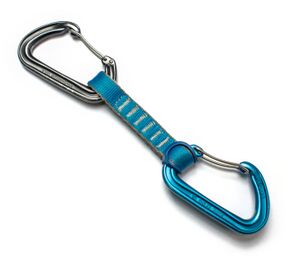Quickdraw
Quickdraw is an essential piece of a climbing equipment used for connecting the rope with a running protections. It consists of two carabiners connected with a sling.
| Quickdraw | |
|---|---|
 | |
| Use(s) | Lead climbing, mountaineering |
Clipping
Clipping with fingers
This clipping method works only with the right hand - carabiner gate faces left, or with the left hand - gate faces right. In other cases, use a different method.
Risks
Aside from safety recommendations for carabiners, there are few more rules to follow while working with quickdraws.
Position the carabiner in a way that the gate is pointed away from the direction of climb. Improper positioning of the gate can lead to unclipping of the carabiner during a fall. Backclipping of the carabiner is also risky as it might also lead to the uncliping of the carabiner. If direction of the climb is uncertain, securing can be done by placing two carabiners with gates pointed in the opposite directions. alternatively, carabiner with a screw-gate can be used for the same purpose.
Self-unclipping of the rope during a fall
If the carabiner is positioned and/or clipped wrong, the lead climber risks that the rope unclips itself from the carabiner during a fall. The risk increases if the carabiner is back-clipped.
Alpine quickdraw (alpine draw)
TODO
Packing and unpacking the alpine quickdraw
TODO
Clipstick
TODO